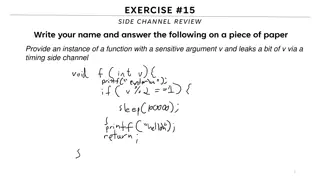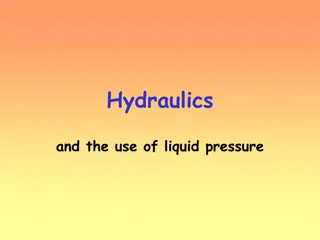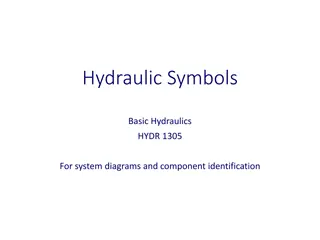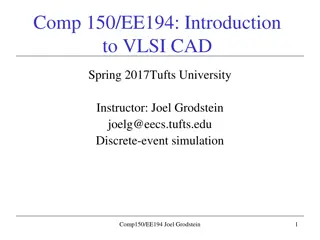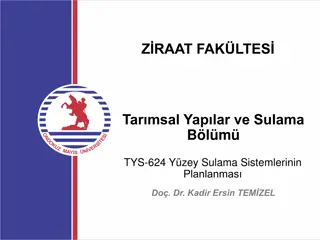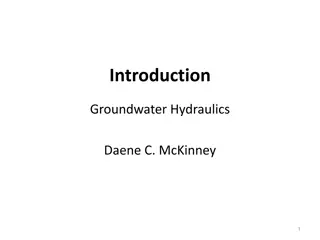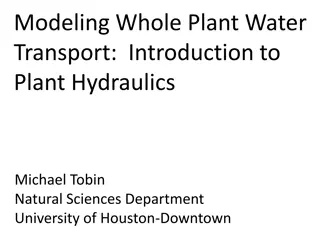Understanding Hydraulics II: Simulation and Analysis in Open Channels
Dive into Hydraulics II to explore complex flow fields, dimensional analysis, pipe network analysis, and design of reticulation systems. Learn about steady and unsteady flows in open channels, Chezy's and Manning's equations, and the different flow regimes in open channels. Gain insights into uniform flow, non-uniform flow, and the importance of similitude in hydraulic modeling techniques.
Download Presentation

Please find below an Image/Link to download the presentation.
The content on the website is provided AS IS for your information and personal use only. It may not be sold, licensed, or shared on other websites without obtaining consent from the author. Download presentation by click this link. If you encounter any issues during the download, it is possible that the publisher has removed the file from their server.
E N D
Presentation Transcript
CVE 304: Hydraulics II (2 Units) Simulation of complex flow fields using sources, sinks, uniform flows and doublets and combination of vortices. Steady and unsteady flows in open channels. Dimension analysis and similitude. Hydraulic modeling techniques. Pipe network analysis. Design of reticulation systems. Unsteady flow in pipes with special emphasis Lecturer: Dr. O.S. Awokola Lectures: Time Table Tutorial: To be decided Assignments 0-5% Midterm 25% (likely to be 2 tests or one plus snap tests) Final 70% References: (1) Fluid Mechanics: J.F. Douglas, J.M. Gasiorek & J.A. Swaffield (2) Fluid Mechanics, Victor L. Streeter, E. Benjamin (3) Fluid Mechanics With Engineering Applications, Robert L. Daugherty & Joseph B. Franzini This course is intended to provide the student with the knowledge of basic principles of Hydraulics On completion of this course the student should be able to:
channel Understand the importance of unsteady flow. Use Chezy s and Mannings equation Explain the concept of dimensional analysis List the applications of dimensional analysis Solve problems using principles of dimensional analysis Define similitude Explain the geometric, kinematic and dynamic similarity Explain the application of principles of geometric, kinematic and dynamic similarity of Reynolds and Froude Model laws OPEN CHANNELS DEFINITION: Every conduit in which a flowing liquid is confined only by the sides and bottom while the surface is free. TYPES: Natural or artificial Dug in the ground with or without protective linings Made of pipes Rectangular, Triangular, Trapezoidal, Circular, Semi- Circular or irregular shape An open channel can be defined also as a conduit in which the liquid flows with a free surface subjected to atmospheric pressure. The flow is caused by the slope of the channel and of the liquid surface.
FLOW REGIMES Q = V A = Q VA Q= Discharge 3 m / V= Velocity m/s A= X-Section Area ( s 2 m dV = 0 dt , dy ) Variation of the above values w.r.t longitudinal distance (L) and time (T) define different flow = 0 dt dV regimes 1.STEADY FLOW: defined under pipe flow as condition in which flow characteristics at any point do not change with time = 0 dL dy , = 0 dL 1.UNIFORM FLOW : refers to the condition in which the DEPTH, SLOPE VELOCITY and CROSS SECTION remain constant over a given length of channel
dy OTHER COMBINATIONS ARE POSSIBLE UNIFORM STEADY FLOW 0 dL dV The equations commonly used in calculating uniform, steady flow are 1.CHEZY EQUATION 0 dL V = A C RS P 1 n V = 2 / 3 1 / 2 R S . The velocity changes from cross-section to cross-section V=average velocity (m/s), C=Chezy s coefficient, R=hydraulic radius= , S= Bed slope of the channel. MANNING S EQUATION 1.NON-UNIFORM FLOW/VARIED FLOW occurs when the depth of low occurs when the depth of flow changes along the length of the open channel this the most widely used formula for open channel flow. Manning s n depends only on the roughness of the channel sides and bottom










